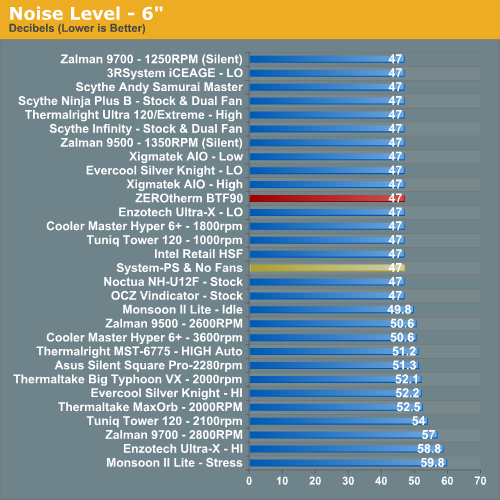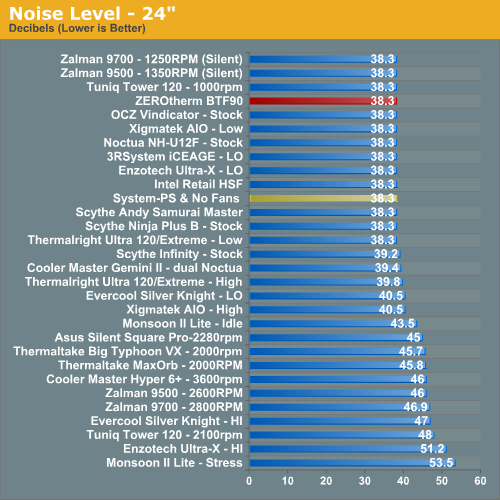ZEROtherm BTF90: Sting like a Butterfly?
by Wesley Fink on August 13, 2007 12:05 AM EST- Posted in
- Cases/Cooling/PSUs
Noise
For many enthusiasts upgrading cooling the goal is maximum stable overclock, and they will live with the inconvenience of a louder system. For other users silence is the most important factor, and these users will forgo maximum overclocking if that increases system noise levels.
There are very few power supplies that do not have a fan. While Zalman and a few others do make expensive fanless power supplies, we have not seen a fanless unit larger than 500W, or one that would be used for seriously overclocking a system. With that in mind the noise level of the system with all fans turned off except the PSU was measured. The power supply used for the cooling test bed is the OCZ PowerStream 520, which is one of the quieter high performance power supplies.
We have also measured the Corsair 620W and Mushkin 650W power supplies which are reported to be quieter than the OCZ. Both the Corsair and Mushkin are indeed quieter at idle or start up speed. However, as soon as load testing begins and the PSU fan speed kicks up the measured noise level is almost exactly the same as the OCZ PowerStream 520W.
We are currently in the process of reevaluating our cooler test bed and planning some updates. The new configuration will include a "quieter" power supply with variable speed and noise levels. We will also update to a P35 chipset motherboard with all passive cooling to the chipset. Changes to the test bed will appear as part of a future roundup with the motherboard, PSU, and CPU all upgraded to more current configurations. We are also investigating a change to a quad-core processor as a further challenge to CPU cooling.
The noise level of the power supply is 38.3 dB from 24" (61cm) and 47 dB from 6" (152mm). The measured noise level of the test room is 36.4 dB, which is a relatively quiet room with a noise floor slightly below that of the OCZ PowerStream 520 PSU.
Noise levels are measured with the test coolers with fans at both low and high speeds. Both measurements were taken at 6" and 24" above the cooling fan on an open case side. Results are then compared to the other coolers/fans tested in this category. Measured noise levels in this chart should be considered worst case. Measurements are taken with an open side of a mid tower case 6" and 24" from the HSF. Real world would be a completely closed case with a further reduction in noise. Please look for both low and high speed results in the noise graphs.


In all cases, under both idle and stress conditions, the BTF90 remains at noise levels below our system noise floor. This is not surprising given the use of a Maglev fan for the BTF90 with a modest maximum output of 42.8 CFM. The quiet operation of the ZEROtherm makes it ideal for use in systems where silence is a main consideration.
For many enthusiasts upgrading cooling the goal is maximum stable overclock, and they will live with the inconvenience of a louder system. For other users silence is the most important factor, and these users will forgo maximum overclocking if that increases system noise levels.
There are very few power supplies that do not have a fan. While Zalman and a few others do make expensive fanless power supplies, we have not seen a fanless unit larger than 500W, or one that would be used for seriously overclocking a system. With that in mind the noise level of the system with all fans turned off except the PSU was measured. The power supply used for the cooling test bed is the OCZ PowerStream 520, which is one of the quieter high performance power supplies.
We have also measured the Corsair 620W and Mushkin 650W power supplies which are reported to be quieter than the OCZ. Both the Corsair and Mushkin are indeed quieter at idle or start up speed. However, as soon as load testing begins and the PSU fan speed kicks up the measured noise level is almost exactly the same as the OCZ PowerStream 520W.
We are currently in the process of reevaluating our cooler test bed and planning some updates. The new configuration will include a "quieter" power supply with variable speed and noise levels. We will also update to a P35 chipset motherboard with all passive cooling to the chipset. Changes to the test bed will appear as part of a future roundup with the motherboard, PSU, and CPU all upgraded to more current configurations. We are also investigating a change to a quad-core processor as a further challenge to CPU cooling.
The noise level of the power supply is 38.3 dB from 24" (61cm) and 47 dB from 6" (152mm). The measured noise level of the test room is 36.4 dB, which is a relatively quiet room with a noise floor slightly below that of the OCZ PowerStream 520 PSU.
Noise levels are measured with the test coolers with fans at both low and high speeds. Both measurements were taken at 6" and 24" above the cooling fan on an open case side. Results are then compared to the other coolers/fans tested in this category. Measured noise levels in this chart should be considered worst case. Measurements are taken with an open side of a mid tower case 6" and 24" from the HSF. Real world would be a completely closed case with a further reduction in noise. Please look for both low and high speed results in the noise graphs.


In all cases, under both idle and stress conditions, the BTF90 remains at noise levels below our system noise floor. This is not surprising given the use of a Maglev fan for the BTF90 with a modest maximum output of 42.8 CFM. The quiet operation of the ZEROtherm makes it ideal for use in systems where silence is a main consideration.










19 Comments
View All Comments
angelicvoices - Friday, March 20, 2009 - link
I have this cooler and I am trying to remove the red LEDs. I can see from your shots where they're supposed to be but I can't actually see them on my cooler. Any help would be appreciated.andereandre - Tuesday, August 14, 2007 - link
my main interest in getting a new cooler, is lowering the noise.Now in these articles the Intel HSF is always classified the same as the best coolers (and system-ps & no fans).
That would suggest that would I be an Intel user, I would not gain anything by replacing it.
I have a X2 4600 however, and I hear the AM2 stock cooler at idle.
Does this mean that de Intel stock cooler is that much better than the AMD one, or is it just the measurement?
I am just worrying that getting me a cooler like this one would not bring me what I am after.
Jodiuh - Monday, August 13, 2007 - link
It's a #$#%ing butterfly on your pc...are you serious?Thinkitect - Monday, August 13, 2007 - link
Why compare this cooler to the Tuniq in the conclusion? It's a different product serving a different purpose. It's like trying to arrange a fight between a heavyweight boxing championship contender with a medium weight rookie.It's fine to put the larger coolers on the same performance graphs to see the difference between categories and price ranges, but for the conclusion and main comparison you should have used the directly competing ones. For example the AC Freezer 7 Pro and the Scythe Ninja Rev.B are popular in the price range (from researching for an HSF last month) - which one of the three outperforms the others? That could have been a sensible conclusion.
Your reviews have a purpose - meaningful and accurate comparisons between products. You are doing an excellent job with the research and data presentation, please get the written analysis on the level. Thank you.
Wesley Fink - Monday, August 13, 2007 - link
Sites like Tiger Driect and Amazon still show the BTF90 selling price as $60, which means it competes at the top. That is why we tried to carefully point out the plus and minus points of the BTF90 compared to the Thermalrights and Tuniq. The BTF90 does not compete that well at the $60 price point.However, at its current selling price of $35 to $45 (after rebate) we think it competes very well and is worth considering.
Spanki - Monday, August 13, 2007 - link
Good article - It's nice to see you broadening your views (audience) somewhat :). If you really want to see bang-for-buck performance, I wish you'd add some like the CoolerMaster Hyper Tx (http://www.svc.com/rr-pch-s9u1-gp.html">for ~$15.00) and/or the Arctic Cooler Freezer 7 Pro (http://www.svc.com/acfzp7.html">generally available for ~$20-$25) to the lineup.Not everyone wants to spend ~$60 - $$80 (or more) on a HSF, so it would be nice to see where these cheaper coolers fall by comparison - of course the results will embarrass some of the higher dollar coolers - but that's kinda the point, isn't it? You don't always get what you pay for.
strikeback03 - Tuesday, August 14, 2007 - link
From tests I have seen, I'd guess the Freezer 7 would be the embarrassed one, but whatever.Wesley Fink - Monday, August 13, 2007 - link
We have added the following info to the overclocking page to put the analysis of this cooler and others in cleare perspective:"There is no doubt that the BTF90 is able to dissipate 150W or more of heat. This merely points out the extreme demands that our overclocking cooling tests make of coolers while we push an X6800 processor to its overclock limits. The power requirements of a Core 2 Duo X6800 processor at rated speed and voltage is around 75 watts. At the overclocked speed of 3.830GHz at the commonly required 1.5375V to 1.5625V the wattage has doubled - to 148W to 153W. At the highest air OC with this X6800 of 3.94GHz with a Thermalright Ultra 120 eXtreme wattage has risen to 165W to 168W.
The stock Intel Retail cooler is really an excellent cooler, and the requirement that a tested cooler must perform better than the included Intel cooler is more demanding than you might think. THe Intel stock cooler topped out at 3.73 GHz at just below 1.5V. This means the stock Intel cooler is dissipating 135W at the highest overclock it could reach. These figures should help keep in perspective the relative efficiency of the coolers being tested and the extreme conditions of our maximum overclock cooling test bed."
RamarC - Monday, August 13, 2007 - link
the 'float like a butterfly' citation on the last page should be corrected.Wesley Fink - Monday, August 13, 2007 - link
The citation has always been Mohammed Ali. The word parsing puts the Ali at the start of the next line.